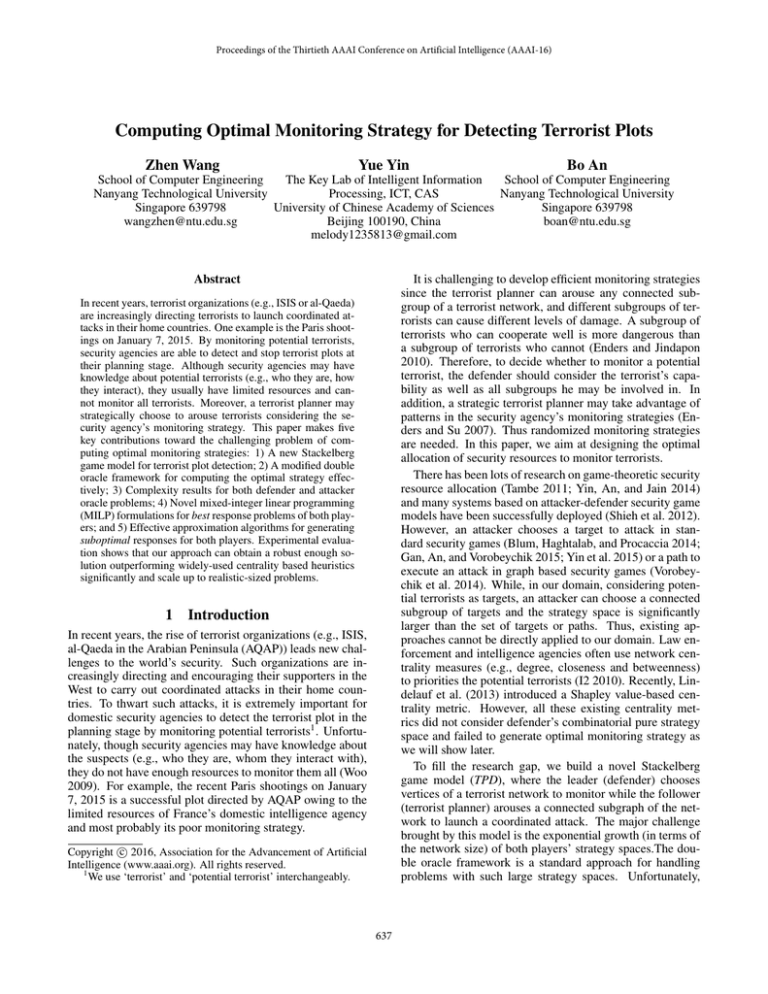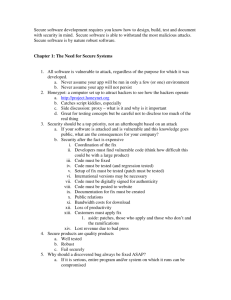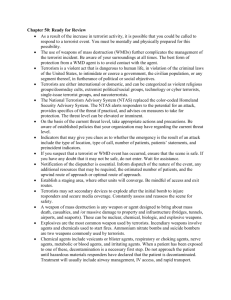
Proceedings of the Thirtieth AAAI Conference on Artificial Intelligence (AAAI-16)
Computing Optimal Monitoring Strategy for Detecting Terrorist Plots
Zhen Wang
Yue Yin
Bo An
School of Computer Engineering
The Key Lab of Intelligent Information
School of Computer Engineering
Nanyang Technological University
Processing, ICT, CAS
Nanyang Technological University
Singapore 639798
University of Chinese Academy of Sciences
Singapore 639798
wangzhen@ntu.edu.sg
Beijing 100190, China
boan@ntu.edu.sg
melody1235813@gmail.com
It is challenging to develop efficient monitoring strategies
since the terrorist planner can arouse any connected subgroup of a terrorist network, and different subgroups of terrorists can cause different levels of damage. A subgroup of
terrorists who can cooperate well is more dangerous than
a subgroup of terrorists who cannot (Enders and Jindapon
2010). Therefore, to decide whether to monitor a potential
terrorist, the defender should consider the terrorist’s capability as well as all subgroups he may be involved in. In
addition, a strategic terrorist planner may take advantage of
patterns in the security agency’s monitoring strategies (Enders and Su 2007). Thus randomized monitoring strategies
are needed. In this paper, we aim at designing the optimal
allocation of security resources to monitor terrorists.
There has been lots of research on game-theoretic security
resource allocation (Tambe 2011; Yin, An, and Jain 2014)
and many systems based on attacker-defender security game
models have been successfully deployed (Shieh et al. 2012).
However, an attacker chooses a target to attack in standard security games (Blum, Haghtalab, and Procaccia 2014;
Gan, An, and Vorobeychik 2015; Yin et al. 2015) or a path to
execute an attack in graph based security games (Vorobeychik et al. 2014). While, in our domain, considering potential terrorists as targets, an attacker can choose a connected
subgroup of targets and the strategy space is significantly
larger than the set of targets or paths. Thus, existing approaches cannot be directly applied to our domain. Law enforcement and intelligence agencies often use network centrality measures (e.g., degree, closeness and betweenness)
to priorities the potential terrorists (I2 2010). Recently, Lindelauf et al. (2013) introduced a Shapley value-based centrality metric. However, all these existing centrality metrics did not consider defender’s combinatorial pure strategy
space and failed to generate optimal monitoring strategy as
we will show later.
To fill the research gap, we build a novel Stackelberg
game model (TPD), where the leader (defender) chooses
vertices of a terrorist network to monitor while the follower
(terrorist planner) arouses a connected subgraph of the network to launch a coordinated attack. The major challenge
brought by this model is the exponential growth (in terms of
the network size) of both players’ strategy spaces.The double oracle framework is a standard approach for handling
problems with such large strategy spaces. Unfortunately,
Abstract
In recent years, terrorist organizations (e.g., ISIS or al-Qaeda)
are increasingly directing terrorists to launch coordinated attacks in their home countries. One example is the Paris shootings on January 7, 2015. By monitoring potential terrorists,
security agencies are able to detect and stop terrorist plots at
their planning stage. Although security agencies may have
knowledge about potential terrorists (e.g., who they are, how
they interact), they usually have limited resources and cannot monitor all terrorists. Moreover, a terrorist planner may
strategically choose to arouse terrorists considering the security agency’s monitoring strategy. This paper makes five
key contributions toward the challenging problem of computing optimal monitoring strategies: 1) A new Stackelberg
game model for terrorist plot detection; 2) A modified double
oracle framework for computing the optimal strategy effectively; 3) Complexity results for both defender and attacker
oracle problems; 4) Novel mixed-integer linear programming
(MILP) formulations for best response problems of both players; and 5) Effective approximation algorithms for generating
suboptimal responses for both players. Experimental evaluation shows that our approach can obtain a robust enough solution outperforming widely-used centrality based heuristics
significantly and scale up to realistic-sized problems.
1
Introduction
In recent years, the rise of terrorist organizations (e.g., ISIS,
al-Qaeda in the Arabian Peninsula (AQAP)) leads new challenges to the world’s security. Such organizations are increasingly directing and encouraging their supporters in the
West to carry out coordinated attacks in their home countries. To thwart such attacks, it is extremely important for
domestic security agencies to detect the terrorist plot in the
planning stage by monitoring potential terrorists1 . Unfortunately, though security agencies may have knowledge about
the suspects (e.g., who they are, whom they interact with),
they do not have enough resources to monitor them all (Woo
2009). For example, the recent Paris shootings on January
7, 2015 is a successful plot directed by AQAP owing to the
limited resources of France’s domestic intelligence agency
and most probably its poor monitoring strategy.
c 2016, Association for the Advancement of Artificial
Copyright Intelligence (www.aaai.org). All rights reserved.
1
We use ‘terrorist’ and ‘potential terrorist’ interchangeably.
637
the state-of-the-art algorithm (Jain, Conitzer, and Tambe
2013) cannot be directly applied to our domain because of
the difference in players’ strategies and the more complicated payoff function in our problem. Indeed, both players’
oracles (i.e., computing one’s best response strategy given
the other’s strategy) are shown to be NP-hard. To overcome these computational barriers, we propose our solution
algorithm DO-TPD which incorporates the following key
components: 1) An efficient initialization procedure to efficiently provide an initial feasible solution; 2) Novel mixedinteger linear programming (MILP) formulations to compute the best response for both players; 3) A greedy algorithm with constant-factor approximation ratio to efficiently
generate improving strategies for the defender; and 4) An
iterated local search heuristic to effectively identify improving attacker strategies. We conduct extensive experiments
showing that our algorithm can obtain a robust enough solution outperforming widely-used centrality based heuristics
significantly and scale up to realistic-sized problems.
2
Kouachi had texted Amedy Coulibaly one hour before the
Charlie Hebdo attack (CNN 2015b).
The challenge for DSGI is how to allocate limited resources efficiently to make the best use of them. Normally, DGSI just allocated limited resources to the highpriority suspects based on the assessment of their dangerousness (CNN 2015a). However, in order to plan such coordinated attacks, the terrorists need to communicate with
each other, thus it is better for the agency to take the network structure into account. Intuitively, since the three
gunmen had to communicate with each other to plan this attack, the agency did not need to keep both the brothers under
surveillance simultaneously to prevent such a plot. In addition, considering that the terrorists could observe the surveillance on them and take advantage of its patterns, the agency
might do better if randomized monitoring schedules were
used. This paper aims to compute the optimal randomized
monitoring strategy for domestic intelligence agencies such
as DGSI.
Motivating Domain
3
In the morning of 7 January 2015, two brothers, Chérif
Kouachi and Saı̈d Kouachi, stormed into the Paris office of
satirical magazine Charlie Hebdo and gunned down 12 people. A few hours later, the third gunman, Amedy Coulibaly
was involved in and killed a policewoman in Montrouge and
four hostages at a kosher supermarket in east Paris. All the
three gunmen were dead after two-day massive manhunt.
This is a well-coordinated plot, directed by AQAP (CNN
2015c). The three gunmen were known to French’s domestic intelligence agency (DGSI) several years ago. They were
connected to each other, and to a large France terrorist cell
known as the Buttes-Chaumont network, which has connections to both ISIS and AQAP. At least one of the brothers
travelled to Yemen in 2011, trained with AQAP and met
local al-Qaeda handlers. The leadership of AQAP claimed
their direction of this event. Amedy Coulibaly coordinated
his attack with the brothers to increase the impact.
DGSI ascribed this successful plot to their limited resources. Some 1,400 French nationals have gone to fight
in Iraq and Syria in the last few years, in which more than
100 have returned. It required more than 10 security personnel, working in shifts, to keep full monitoring (e.g., listen
to phone calls and watch suspicious contacts) on a single
suspect, while DGSI only has the manpower to monitor one
fifth of all suspects in home (BBC 2015a). France monitored the brothers for over two years, but the monitoring terminated at the end of 2013 and June 2014, respectively. Because they seemed to be inactive targets that were quiet for a
long time, the intelligence agency shifted limited resources
to other high-priority targets (CNN 2015a). However, because Chérif Kouachi was previously arrested based on intercepted phone conversations, the Kouachis were aware that
they were being watched and avoided any activities that
might draw the attention of the agency. When DGSI took
eyes off them, they grabbed the opportunity. According to
the Paris Public Prosecutor’s office, Amedy Coulibaly and
Chérif Kouachi had exchanged more than 500 phone calls
on their wives’ phones in 2014 (BBC 2015b); even Chérif
Terrorist Plot Detecting Game (TPD)
We define the problem of detecting terrorist plots as a leaderfollower (defender-attacker) Stackelberg game. The security agencies (e.g., DGSI) are the leader (defender) who acts
first and the terrorist planners (e.g., AQAP, ISIS) observe
the leader’s strategy and then respond to it. The communication network of the terrorists is represented by a graph
G(V, E) with each vertex v ∈ V representing a terrorist (or
a group behaving like a single terrorist), and an edge between two vertices representing that two terrorists can communicate/cooperate with each other. In addition, each vertex
is associated with a capability value τv ≥ 0, representing the
terrorist’s financial means, weapons accessibility or bomb
building skills. Although the size and structure of the terrorist network are growing or shrinking over time, the terrorist
planner will not plan a plot using the just returned terrorists
or newly constructed communication links. Thus we assume
that the network structure is static. Considering that the defender may have uncertainty associated with terrorists’ capabilities, we also conduct sensitivity analysis in Section 5.
Formally, denote NG (v) (or simply N (v)) as the set of
neighbors of v ∈ V in G, i.e., u ∈ NG (v) iff (v, u) ∈ E.
For a subset V ⊆ V , we can similarly denote the subset’s
neighbors as N (V ) = {u ∈ V \ V |(v, u) ∈ E, v ∈ V }.
The subgraph (V , E ∩ V2 ) induced by V is denoted by
G[V ].2 If there exists a path in E ∩ V2 between every pair
of vertices in V , the subgraph G[V ] is connected. We denote the collection of all the subsets V ⊆ V whose induced
subgraphs of G are connected as C(G) (or simply C ).
Strategies. A pure defender strategy S = Sv is an assignment
of the R monitoring resources to R vertices, i.e.,
v∈V Sv = R, where Sv ∈ {0, 1} and Sv = 1 indicates
that the vertex v is monitored. The defender’s pure strategy
space is denoted by S. A mixed defender strategy is a probability distribution over pure strategies, i.e., x = xS with
2
Since non-induced subgraphs are not considered, we will often
omit the word induced in this paper.
638
Thus, the optimal mixed strategy x of the defender can be
computed by solving the following linear program (LP).
xS representing the probability that S is played.
The attacker can choose any subset of vertices to plan an
attack. In order to fulfill his planning or coordination activity, he must ensure that information can be communicated
among all selected terrorists. Thus the attacker will choose
a subset V ∈ C , and we denote an attacker’s pure strategy as
a vector A = Av , where Av = 1 if v ∈ V , 0 otherwise.
The attacker’s pure strategy space is denoted by A. A mixed
attacker strategy is denoted by y = yA with yA representing the probability that A is played. With a slight abuse of
notation, we also use S and A to denote subsets of vertices,
such that v ∈ S (or A) if Sv = 1 (or Av = 1).
max
s.t.
v∈A
(τv + δ
u∈NG[A] (v)
τu )
xS ≥ 0
S∈S
(1 − zS,A )xS
4
A∈A
(1 − zS,A )yA P (A)
(6)
(7)
Approach
The double oracle framework is a standard approach for
solving zero-sum games with large strategy spaces (Jain,
Conitzer, and Tambe 2013). It first computes the equilibrium strategy for a significantly smaller restricted game and
then iteratively computes improving strategies for both players and finally converges to a global equilibrium. The key
problem thus reduces to computing the players’ improving
strategies, which are called defender oracle and attacker oracle, respectively. Unfortunately, the state-of-the-art double
oracle algorithm SNARES (Jain, Conitzer, and Tambe 2013)
cannot compute players’ oracles in TPDs due to different
strategy settings and payoff functions. Specifically, SNARES
solves games where the defender blocks edges (instead of
vertices as in TPDs) in a graph, and the attacker chooses
a path connecting a source and a target (instead of a connected subgraph as in TPDs) to launch an attack, bearing a
much smaller strategy space than that in TPDs. Moreover,
all the paths with the same target have the same payoff in
SNARES’s domain, while each subgraph has a unique associate payoff decided by the vertices and their network structure in TPDs. Therefore, to apply the double oracle framework to solving TPDs, improvements need to be made on
top of the existing framework. We propose our algorithm
DO-TPD (an Double Oracle algorithm for TPDs) with the
following novel features: 1) An efficient initialization procedure; 2) Novel mixed-integer linear programming (MILP)
formulations for both players’ oracles; 3) A greedy algorithm with constant-factor approximation ratio to speed up
the computation of defender oracle; and 4) An iterated local search heuristic to speed up the computing of attacker’s
improving strategies. Next, we start with an overview of
DO-TPD, and then present its key components in detail.
(1)
(2)
Where zS,A indicates whether the defender strategy S and
attacker strategy A overlap, i.e.,zS,A = 1 if S ∩ A = ∅, 0
otherwise.
Similarly, the attacker’s expected utility Ua (S, y) of playing mixed strategy y against S is:
Ua (S, y) =
∀S ∈ S
(4)
(5)
However, it is impractical to directly solve this LP since
the defender strategy space S grows exponentially with the
number of resources R, whereas the attacker strategy space
A grows exponentially with the network size |V |.
Notice that we assume homogenous positive network externality effect, while our approach can be easily extended to
handle other payoff functions such as heterogenous externality effect (Lindelauf, Hamers, and Husslage 2013).
Given a defender’s mixed strategy x and an attacker’s
pure strategy A, the expected attacker utility is:
Ua (x, A) = P (A)
∀A ∈ A
S∈S
Utility. As in most related works, we assume a zero-sum
game. Given a defender allocation S and an attacker subset A, if S ∩ A = ∅, the terrorist plot is not detected by
the security agency and the attacker succeeds; otherwise the
attacker fails. If the attacker succeeds, he will gain a payoff P (A) = P (G[A]) and the defender will receive −P (A),
otherwise both players will gain 0.
The payoff of a connected subgraph G[A] represents the
potential damage of the terrorist attack by the subgraph,
which generally depends on both the capabilities of vertices and network structure of G[A] (Enders and Su 2007;
Enders and Jindapon 2010; Lindelauf, Hamers, and Husslage 2013). Firstly, to successfully launch a terrorist attack,
tasks such as financing and weapon acquiring/transport have
to be conducted. Each individual terrorist v has some capability τv of performing such tasks. A more skillful terrorist
can perform such tasks better and cause more damage. Secondly, if the terrorists can coordinate their activities easily,
they can cause greater damage. Therefore, we assume that
each vertex v ∈ A can provide an external effect δ · τv to
each of its neighbor vertices, where δ measures the extent of
this positive network externality. Thus, P (A) is defined as:
P (A) =
U
U ≤ Ud (x, A)
xS = 1
4.1
DO-TPD Overview
DO-TPD is sketched in Algorithm 1. Line 1 first initializes DO-TPD. A small strategy space S , A is generated by
solving a linear program LWA-LP where attacker strategy is
restricted to “lone-wolf” attack using a single vertex. Then
DO-TPD solves a restricted version of TPD, i.e., Eqs.(4)-(7)
with S, A replaced by S , A (CoreLP, Line 3). The restricted TPD can be solved very efficiently as the strategy
space is rather small. Obviously, the solution obtained, being a SSE of the restricted TPD, does not necessarily form
SSE to the original TPD. Both players may want to use other
(3)
We can define Ua (x, y) = S xS Ua (S, y) = A yA Ua (x, A).
And we have Ud = −Ua due to the zero-sum assumption.
Equilibrium. The Stackelberg equilibrium (SSE) is the
same as the maxmin equilibrium given the zero-sum assumption (the defender maximizes her minimum utility,
or equivalently, minimizes the maximum attacker utility).
639
Algorithm 2: betterO-D (x, y)
Algorithm 1: DO-TPD overview
1
2
3
4
5
6
7
8
9
10
11
Initialize S , A using LWA-LP;
repeat
(x, y) ← CoreLP(S , A );
S + ← betterO-D(x, y);
if S + = ∅ then S + ← {bestO-D(x, y)} ;
S ← S ∪ S + ; /∗ Lines 4 − 6: Defender Oracle∗ /
A+ ← betterO-A(x, y);
if A+ = ∅ then A+ ← {bestO-A(x, y)};
A ← A ∪ A+ ; /∗ Lines 7 − 9: Attacker Oracle∗ /
until S + = ∅ and A+ = ∅;
return (x, y).
1
2
3
4
5
6
7
8
max
s.t.
v∈V
cv ∈ [0, 1]
∀v ∈ V
∀v ∈ V
A∈A
zA ≤
(1 − zA )yA P (A)
v∈V
Av Sv
∀A ∈ A
(12)
(13)
Sv ≤ R
(14)
Sv ∈ {0, 1}, zA ∈ [0, 1]
(15)
betterO-D As presented in Algorithm 2, betterO-D repeatedly starts from each single vertex v ∈ V and, in a greedy
manner, iteratively selects vertices that brings the maximum
marginal utility (Line 5). Notably, betterO-D can generate
multiple strategies in a single run, which significantly reduces the number of overall iterations in practice. Besides, a
(1 − 1e )-approximation of betterO-D is shown in Theorem 2.
We can even totally rely on betterO-D and exclude bestO-D
from the loop (i.e., remove Line 5 from Algorithm 1), which
offers an approximate solution to the original TPD, while a
(1 − 1e )-approximation ratio still holds (Theorem 3).
Theorem 2. Let U = maxS∈Sbetter Ud (S, y), where Sbetter
is the solution returned by betterO-D. Let U ∗ =
1 4
d (∅,y)
maxS∈S Ud (S, y). Then UU∗−U
−Ud (∅,y) ≥ 1 − e .
(8)
(9)
(10)
(11)
Furthermore, a mixed strategy x can be efficiently sampled
to implement this marginal c with existing approaches such
as the Comb Sampling algorithm (Tsai et al. 2010). The
support set is then used as the initial pure strategy set for the
defender (i.e., S = {S|xS > 0}).
4.3
Here, Eq.(14) enforces that the defender covers at most R
vertices; Eq.(13) ensures zA = 1 if A ∩ S = ∅ (i.e., some
vertex in subgraph A is monitored by S), and 0 otherwise.
Unfortunately, solving bestO-D turns out to be NP-hard
(Theorem 1). Therefore, to speed up the process, we propose
a faster oracle betterO-D. betterO-D trades off by computing
suboptimal (“better”) solutions for Eqs.(12)-(15), which in
most cases are good enough to meet the criterion Ud (S, y) >
Ud (x, y). In this fashion, bestO-D only needs to be called
when betterO-D fails to find an answer.
Theorem 1. The bestO-D problem is NP-hard.3
Initialization Procedure
U
U ≤ −τv (1 − cv )
cv ≤ R
−
v∈V
To initialize DO-TPD, we first restrict the attacker’s pure
strategy to “lone-wolf” attack, i.e., the terrorist planner only
inspires a single terrorist to launch a attack, thus A =
{{v}|v ∈ V }. In this case, the graph structure can be totally
ignored and the game degenerates to the simplest form of security game, where the defender’s strategy can be compactly
represented by marginal coverage rate (i.e., the probability
of being protected) of each target (vertex). The following
LP, called “lone-wolf” attack LP (LWA-LP), computes the
optimal marginal coverage c.
max
s.t.
if Ud (S, y) > Ud (x, y) then Sbetter = Sbetter ∪ {S} ;
return Sbetter .
strategy S satisfying Ud (S, y) > Ud (x, y) is added to the current pure strategy space S . The best defender oracle bestOD thus finds an improving strategy by maximizing Ud (S, y)
over the entire pure strategy space, and is formulated as the
following MILP.
strategies out of S , A to improve their utilities. DO-TPD
allows them to do so with the subsequent oracles (Lines 4–
6 and Lines 7–9). Specifically, in Lines 4–6, DO-TPD first
calls efficient betterO-D (better Oracle for Defender) to find
a set of improving strategies for the defender. If betterO-D
fails to return an answer, DO-TPD proceeds to bestO-D (best
Oracle for Defender) which returns at most one improving
strategy and runs slower, but guarantees that no improving
strategy exists when it fails to find one. In Lines 7–9, DOTPD searches for improving attacker strategies in the similar
manner. The process repeats until no improving strategy can
be found for both players (Line 10), when the solution obtained is provably optimal to the original TPD (McMahan,
Gordon, and Blum 2003).
4.2
Sbetter = ∅
for v ∈ V do
S ← {v};
while |S| < R do
v ∗ ← arg maxv Ud (S ∪ {v}, y);
S ← S ∪ {v ∗ };
Theorem 3. Let (x∗ , y∗ ) be the optimal solution of a TPD,
and let (x , y ) be the solution computed by Algorithm 1 with
(x ,y )−Ud (∅,y )
1
Line 5 skipped. Then UUdd(x
∗ ,y∗ )−U (∅,y ) ≥ 1 − e .
d
Defender Oracle (DO)
bestO-D The goal of defender oracle is to find pure strategies that can improve the defender’s utility (given that the attacker sticks to the current strategy). We call such strategies
improving strategies. Given a restricted game S , A and its
solution (x, y), the defender’s utility can be improved if any
3
All the proofs in this paper are in the online appendix: http:
//www.ntu.edu.sg/home/boan/papers/AAAI16 Monitor Appendix.
pdf
4
In case Sbetter = ∅, we simply relax the criterion in Line 7 of
Algorithm 2, and accept all solutions.
640
4.4
Attacker Oracle (AO)
Algorithm 3: betterO-A (x, y)
bestO-A The attacker oracle works in the similar way. The
best oracle bestO-A maximizes Ua (x, A) for an improving
strategy A such that Ua (x, A) > Ua (x, y). We formulate
bestO-A as the following MILP.
max
S∈S xS · US
3
4
5
6
(17)
(18)
7
8
9
(19)
10
(u,v)∈E
v∈V
ωv ≤ min(Av , 1−Au ),
h+
uqv −
(u,q)∈E
2
(16)
s.t. US ≤ M · (1 − Av )
∀S ∈ S , v ∈ S
Au +Av −1 ≤ γuv ≤ min(Au , Av ) ∀(u, v)∈E
A v τv +
δγuv (τu + τv ) ∀S ∈ S US ≤
1
ωv =1
∀u,v∈V, u<v
if Ua (x, A) > Ua (x, y) then Abetter ← Abetter ∪ {A};
return Abetter .
(20)
Algorithm 4: LocalSearch (v, A, x)
v∈V
V
h−
uqv ≥ ωu −(1−Av ) ∀(u, v) ∈ (2 ) (21)
1
(u,q)∈E
−
h+
∀(u, q) ∈ E, v ∈ V
uqv ≤ γuv , huqv ≤ γuv
Av ∈ {0, 1}, γuv ∈ [0, 1], ωv ≥ 0, US ≥ 0
Abetter ← ∅;
for v ∈ V do
A ← LocalSearch (v, {v}, x), k ← 1;
while no termination condition is met do
(k)
A ← randomly pick one from Fv (A);
A ← LocalSearch (v, A , x);
if Ua (x, A ) > Ua (x, A) then A ← A , k ← 1;
else k ← min(k + 1, kmax );
2
(22)
(23)
3
4
5
Here, US captures the attacker’s utility against defender’s
pure strategy S. This is guaranteed along with Eqs.(17)(19), where γuv is a binary indicator such that γuv = 1 iff
both endpoints of edge (u, v)∈E are selected by the attacker.
In Eq.(20), ωv = 1 only when v is the smallest indexed
vertex5 selected by the attacker. Furthermore, Eqs.(21)-(22)
ensures connectivity of the selected subgraph by enforcing
a unit flow from the smallest indexed vertex, say v0 , to any
selected vertices via edges in the selected subgraph, where
h+
uvq represents the amount of flow from v0 to v that passes
through edge (u, q) ∈ E. The above MILP thus maximizes
Ua (x, A) over the entire attacker strategy space.
6
Repeat
v ∗ ← arg maxv∈N (A) Ua (x, A ∪ {v});
if Ua (x, A ∪ {v ∗ }) > Ua (x, A) then A ← A ∪ {v ∗ };
else
v ∗ ← arg maxv∈A\(P(A)∪{v}) Ua (x, A \ {v}) if
Ua (x, A \ {v ∗ }) > Ua (x, A) then A ← A \ {v ∗ };
else return A ;
After initializing with LocalSearch (Line 3), betterO-A repeatedly generates a random new starting point A from the
neighborhood of A (Line 5), and applies LocalSearch again
for a new local optimal solution (Line 6). Afterwards, the
incumbent A and neighborhood size k are updated systematically in Lines 7–8, to avoid getting stuck in local optimum. The loop repeats until a termination condition is met:
i) the incumbent A is a better response for the attacker, i.e.,
Ua (x, A) > Ua (x, y); ii) for cmax consecutive iterations,
the incumbent A is not updated, or iii) the total number of
iterations reaches a pre-defined constant tmax .
Theorem 4. The bestO-A problem is NP-hard, even when
network externality is zero, i.e., δ = 0.
betterO-A As presented in Algorithm 3, betterO-A generates an attacker pure strategy (i.e., a connected subgraph)
containing each starting vertex v ∈ V . The core of each iteration (Lines 3–8) is designed based on the basic Variable
Neighborhood Search framework (Hansen and Mladenović
2001). It utilizes two key components LocalSearch and kdistance neighbourhood Fv(k) .
Specifically, LocalSearch (v, A, x) (Algorithm 4) starts
from a given strategy A, and it consecutively tries to add a
best vertex or remove a worst vertex in the hope of improving utility Ua , and stops when both tries fail. LocalSearch
never removes the root vertex v designated in the input, and
never breaks connectivity of the subgraph, so that P(A)∪{v}
is always excluded from removing the candidates, where
P(A) = {v ∈ A|A\{v} ∈
/ C} is the set of cut vertices of the
subgraph induced by A. While identifying P(A) is computationally more expensive, LocalSearch only tries to remove
a vertex when no vertex can be added to improve the solu(k)
tion. Fv (A) represents the set of attacker pure strategies
containing vertex
v and within Hamming distance k
of A,
i.e., Fv(k) (A) = A ∈ C v ∈ A , u∈V | Au −Au |≤ k .
5
Experimental Evaluation
We evaluate the performance of our approach through extensive experiments. All LPs and MILPs are solved with
CPLEX (version 12.6). All computations are performed on
a machine with a 3.20GHz quad core CPU and 16.00GB
memory. The parameters in betterO-A (Algorithm 3), tmax ,
cmax and kmax are set to |V |, 0.2 ∗ |V | and 3, respectively.
The number of resources R is set to |V5 | unless otherwise
specified. All the results are averaged over 50 samples.
We conduct experiments on three types of graph structures which are widely used to model terrorist organisations:
(i) Random trees (RT), where every new vertex is attached
to a randomly picked incumbent; (ii) Erdős-Rényi random
graphs (ER(V , M )), where exactly M edges are randomly
constructed between all the possible pairs of vertices (Erdős
and Rényi 1959); (iii) Barabási-Albert scale-free networks
(BA(k)), where each new vertex is connected to k incumbents using a preferential attachment mechanism (Barabási
and Albert 1999). Because real-world terrorist networks are
commonly sparse (Krebs 2002), we use ER random graphs
with parameters M = V, 2V , labelled as ER(1) and ER(2),
respectively, and use BA scale-free networks with parame-
5
We can assign an index to each node, without introducing a
new symbol, we simply use the node v to present its index.
641
500
400
200
100
400
300
200
300
250
200
150
100
100
0
10
20
30
40
50
60
70
80
90
20
30
40
50
60
70
80
90
0
10
100
20
Number of Terrorists
Number of Terrorists
(a) RT
1200
1200
1000
1000
800
800
600
400
30
40
50
60
70
80
90
0
100
10
15
20
400
25
30
35
40
45
50
55
0
60
10
15
20
25
Number of Terrorists
Number of Terrorists
(b) BA(1)
600
200
200
50
0
10
100
1400
Runtime(s)
300
350
500
Runtime(s)
400
450
600
Runtime(s)
Runtime(s)
700
DO-TPD
DO-TPD/singleResponse
DO-TPD/randomstart
DO-TPD/Appro
FullLP
500
Runtime(s)
600
(c) ER(1)
30
35
40
45
50
55
60
Number of Terrorists
(d) BA(2)
(e) ER(2)
100
EXACT
DO-TPD/Appro
1
10
20
30
40
DCM
DCP
50
60
WCM
WCP
70
SCM
SCP
80
Number of Terrorists
(f) RT
90
100
10
1
10
20
30
40
50
60
70
80
Number of Terrorists
(g) BA(1)
90
100
100
Attacker Utiliy
10
100
Attacker Utility
Attacker Utility
Attacker Utility
100
Attacker Utility
100
10
10
1
20
40
60
80
1
100
10
20
Number of Terrorists
30
40
50
10
1
60
10
20
(h) ER(1)
30
40
50
60
Number of Terrorists
Number of Terrorists
(i) BA(2)
(j) ER(2)
Figure 1: Runtime ((a) - (e)) and attacker utility ((f) - (j), y-axis is plotted on a log scale)
ters k = 1, 2, labelled as BA(1) and BA(2), respectively. The
capability of each vertex τv is randomly chosen in [1, 5], and
the network externality measure δ is fixed to be 0.1.
We compare the scalability of four versions of
our algorithms: (i) DO-TPD: Algorithm 1; (ii) DOTPD/singleResponse: revised DO-TPD which only generates one improving strategy for both players per iteration;
(iii) DO-TPD/randomstart: modified DO-TPD where S and A are initialized with several randomly generated pure
strategies; (iv) DO-TPD/Appro: an approximation variant
of DO-TPD which does not call bestO-A and bestO-D. The
naı̈ve algorithm of solving the LP in Eqs.(4)-(7) directly
(FullLP) is also included as a benchmark.
To evaluate the solution quality of our algorithms, we introduce six centrality measure based heuristic baselines. The
solution quality of a baseline strategy x is assessed in terms
of attacker utility Ua (x, y), where y is the attacker best
response of x. A lower attacker utility indicates a higher
defender utility given the zero-sum assumption. The baselines are: (i) DCP: a pure defender strategy monitoring vertices with top R degree values; (ii) DCM: a defender mixed
strategy where marginal coverage probability of each vertex is normalized degree centrality; (iii) WCP: a pure defender strategy monitoring vertices with top R node capability values; (iv) WCM: a defender mixed strategy where
marginal coverage probability of each vertex is normalized
weight centrality; (v) SCP: a pure defender strategy monitoring vertices with top R Shapley values computed by
FasterSVCG algorithm in (Michalak et al. 2013); (vi) SCM:
a defender mixed strategy where marginal coverage probability of each vertex is normalized Shapley value based centrality. Note that, given the marginal coverage probabilities,
all the mixed strategies are generated using the Comb Sampling algorithm (Tsai et al. 2010).
10
Attacker Utility
Attacker Utility
10
EXACT
DCM
WCM
DO-TPD θ=0.1
DO-TPD θ=0.2
DO-TPD θ=0.3
1
0.1
2
4
6
8
EXACT
DCM
WCM
DO-TPD θ=0.1
DO-TPD θ=0.2
DO-TPD θ=0.3
1
0.1
10
12
14
16
Number of Defender Resources
(a) ER(1), |V | = 20
18
2
4
6
8
10
12
14
16
18
Number of Defender Resources
(b) BA(2), |V | = 20
Figure 2: Robustness results on different networks
about 20. Comparing with DO-TPD/singleResponse and
DO-TPD/randomstart, it is revealed that generating multiple
better responses and LWA-LP initialization procedure in DOTPD can reduce the number of overall iterations. Overall,
DO-TPD and DO-TPD/Appro perform the best and can scale
up to realistic-sized problems. As stated in Section 2, France
has about 100 such potential terrorists, which is within the
scalability of our approach.
Solution Quality Analysis. Figure 1 compares the solution quality obtained from our approaches with those obtained from the 6 heuristic baselines, in which EXACT repents the solution quality obtained by DO-TPD. Results
show that the solutions of all the heuristic baselines are very
bad in general and become worse with the increasing network size, while DO-TPD/Appro can always achieve an almost optimal solution. WCP performs dramatically worse
in all the cases because it was designed entirely without
considering the network structure. All the mixed strategy based heuristics (i.e., DCM, WCM and SCM) perform
much better than corresponding pure strategy based heuristics (i.e., DCP, WCP and SCP), which confirms the necessity of using randomized monitoring schedules. The good
performance of DO-TPD/Appro indicates the effectiveness
of our better-response oracles.
Scalability Analysis. In Figures 1(a) - 1(e), we compare
the scalability of the proposed algorithms on 5 types of networks. Results show that DO-TPD and DO-TPD/Appro outperform alternatives significantly by several orders of magnitude. The runtime of FullLP exponentially increases with
the size and runs out of memory when the network size is
Robustness. The defender’s estimation of terrorists’ capability may not be perfect, thus we analyze the performance of DO-TPD considering noise of τ . Let τ̂ be the
defender’s estimation of τ while τ̂ is drawn uniformly from
642
45
30
15
10
5
35
Attacker Utility
Attacker Utility
EXACT
DCM
WCM
SCM
DCP
WCP
SCP
20
0
CNN. 2015b. Report: Chérif Kouachi texted Coulibaly an hour
before Paris attacks began. http://edition.cnn.com/2015/02/17/
world/france-charlie-hebdo-attacks/.
CNN.
2015c.
Who are suspects in two violent
French standoffs? http://edition.cnn.com/2015/01/08/europe/
paris-charlie-hebdo-shooting-suspects/.
Enders, W., and Jindapon, P. 2010. Network externalities and
the structure of terror networks. Journal of Conflict Resolution
54(2):262–280.
Enders, W., and Su, X. 2007. Rational terrorists and optimal
network structure. Journal of Conflict Resolution 51(1):33–57.
Erdős, P., and Rényi, A. 1959. On random graphs. Publicationes Mathematicae Debrecen 6:290–297.
Gan, J.; An, B.; and Vorobeychik, Y. 2015. Security games
with protection externality. In AAAI, 914–920.
Hansen, P., and Mladenović, N. 2001. Variable neighborhood
search: Principles and applications. European Journal of Operational Research 130(3):449–467.
I2. 2010. Analyst’s notebook 8, Social network analysis
whitepaper. www.i2group.com.
Jain, M.; Conitzer, V.; and Tambe, M. 2013. Security scheduling for real-world networks. In AAMAS, 215–222.
Krebs, V. E. 2002. Mapping networks of terrorist cells. Connections 24(3):43–52.
Lindelauf, R.; Hamers, H.; and Husslage, B. 2013. Cooperative game theoretic centrality analysis of terrorist networks:
The cases of Jemaah Islamiyah and Al Qaeda. European Journal of Operational Research 229(1):230–238.
McMahan, H. B.; Gordon, G. J.; and Blum, A. 2003. Planning
in the presence of cost functions controlled by an adversary. In
ICML, 536–543.
Michalak, T. P.; Rahwan, T.; Jennings, N. R.; Szczepański,
P. L.; Skibski, O.; Narayanam, R.; and Wooldridge, M. J.
2013. Computational analysis of connectivity games with applications to the investigation of terrorist networks. In IJCAI,
293–301.
Shieh, E.; An, B.; Yang, R.; Tambe, M.; Maule, B.; and Meyer,
G. 2012. PROTECT: An application of computational game
theory for the security of the ports of the United States. In
AAAI, 2173–2179.
Tambe, M. 2011. Security and Game Theory: Algorithms, Deployed Systems, Lessons Learned. Cambridge University Press.
Tsai, J.; Yin, Z.; Kwak, J.; Kempe, D.; Kiekintveld, C.; and
Tambe, M. 2010. Urban security: Game-theoretic resource
allocation in networked physical domains. In AAAI, 881–886.
Vorobeychik, Y.; An, B.; Tambe, M.; and Singh, S. P. 2014.
Computing solutions in infinite-horizon discounted adversarial
patrolling games. In ICAPS, 314–322.
Woo, G. 2009. Intelligence constraints on terrorist network
plots. In Memon, N.; David Farley, J.; Hicks, D.; and Rosenorn,
T., eds., Mathematical Methods in Counterterrorism. 205–214.
Yin, Y.; An, B.; and Jain, M. 2014. Game-theoretic resource
allocation for protecting large public events. In AAAI, 826–834.
Yin, Y.; Xu, H.; Gan, J.; An, B.; and Jiang, A. X. 2015.
Computing optimal mixed strategies for security games with
dynamic payoffs. In IJCAI, 681–687.
40
25
EXACT
DCM
WCM
DCP
WCP
30
25
20
15
10
5
2
4
6
8
10
12
14
16
Number of Defender Resources
(a) small 9/11 network
18
0
4
8
12
16
20
24
28
32
36
Number of Defender Resources
(b) bigger 9/11 network
Figure 3: Attacker utility results on 9/11 networks
τ · [1 − θ, 1 + θ]. We compare the attacker utility of DO-TPD
under different degrees of uncertainty, with the optimal solution, denoted by EXACT, and two best heuristic solutions
(i.e., DCM and WCM). Figure 2 shows a decreasing efficiency of DO-TPD with increasing θ. The solutions are still
near-optimal and outperform DCM and WCM significantly.
Application on 9/11 Terrorist Network. We conduct experiments on two 9/11 networks (a small one with 19 vertices, who are directly responsible for this attack, and a
bigger one with 37 vertices including accomplices (Krebs
2002)) with the same node capabilities and payoff function
as Lindelauf et al. (2013), to compare our DO-TPD with
these centrality metrics based heuristics, and DO-TPD can
solve both networks efficiently, no matter how many defender resources are provided. The solution qualities are depicted in Figure 3, from which we can see that DO-TPD outperforms all heuristics significantly, especially with scarce
defender resources, which is exactly the case in reality.
6
Conclusion
This paper presents the first work on applying Stackelberg
security games for detecting terrorist plots. We propose
an efficient double oracle framework based algorithm with
novel MILPs for NP-hard best-response oracles. We also
provide a greedy defender better-response oracle with 1 − 1e
approximation ratio and a fast attacker better-response oracle based on iterated local search. Experimental results show
that our algorithm can obtain a robust enough solution outperforming widely-used centrality based heuristics significantly and can scale up to realistic-sized problems.
References
Barabási, A.-L., and Albert, R. 1999. Emergence of scaling in
random networks. Science 286(5439):509–512.
BBC. 2015a. Charlie Hebdo attack: A French intelligence
failure? http://www.bbc.com/news/world-europe-30760656.
BBC. 2015b. Paris attacks: Suspects’ profiles. http://www.bbc.
com/news/world-europe-30722038.
Blum, A.; Haghtalab, N.; and Procaccia, A. D. 2014. Learning
optimal commitment to overcome insecurity. In NIPS, 1826–
1834.
CNN. 2015a. French monitored Kouachi brothers but lost
interest, despite red flags. http://edition.cnn.com/2015/01/10/
europe/kouachi-brothers-surveillance/.
643






